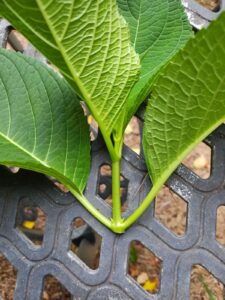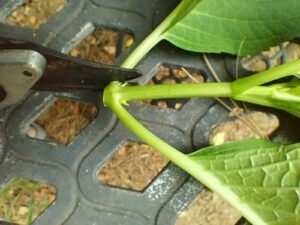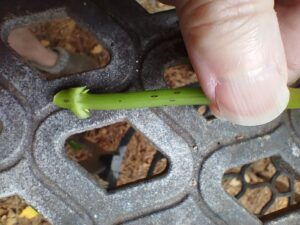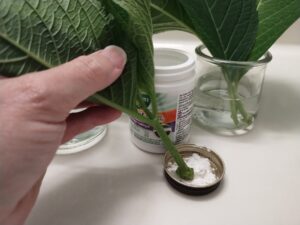
The lower half of my grandmother’s apartment window was filled with African violets. Occasionally, she accidentally broke off a violet leaf when she watered or rotated the pots, but she just stuck it into another pot, and it grew into a new plant. I thought she was magical.
My grandmother wasn’t magical, but she could take advantage of the almost magical indeterminate growth property of plants, which contain meristematic tissues that can become whatever organ the plant needs. When Maw-Maw put the petiole (leaf stem) of the broken off violet leaf into moist soil, the wounded tissue began dividing cells from the meristem. Some of the new cells developed into root cells because the leaf needed roots to survive. A few weeks later, a daughter plant developed at the broken end of the petiole and pushed up through the soil.
Vegetative propagation is a reproduction strategy of plants, but it also allows us to replicate the exact genetic characteristics of a particular plant and to increase our plant inventory through economical means.

African violets are easy to propagate from leaf cuttings. It’s important to keep the soil moist as the roots develop. Violets will also grow roots if the petiole is placed in water. Other plants need a larger section of the parent for successful propagation. These sections, taken from the growing tip of a plant shoot or root, or a middle section of a plant stem, must contain at least one node. Meristems occur in the shoot and root tips and in nodes on plant stems where leaves are attached.
Stem cuttings should have at least two notes, but not too many, since the developing roots won’t be able to support a large cutting. Earlier this month, took softwood cuttings from the green, growing stems of a hydrangea in my yard (May through July is a good time to take softwood cuttings from hydrangeas). I cut the stem just below the third pair of leaves, then removed that lowest pair below the nodes in the leaf axils. Next, I dipped the trimmed stem into plant rooting hormone, which helps cuttings root more quickly and abundantly. Then the stem end goes into moist, loose, light propagation media that provides a good growing environment for cuttings. Propagation mix and rooting hormone are available at most garden supply stores.

With appropriate moisture, light exposure, and temperature, the hydrangea cuttings should root in 3-5 weeks. I’ll grow them indoors through the winter. In the spring, I’ll gradually expose them to outdoor conditions a few hours each day until they are hardened off for life outside. I’ve done this successfully with coleus and begonias, as well.
Layering and division are vegetative propagation techniques we can use on landscape plants. Layering involves bending a branch of a shrub down to the ground and covering part of the stem with soil to encourage rooting. The parent plant continues to nourish the branch, but when the stem section forms good roots, it can be cut from the parent and become a new plant.

Division is useful for thinning overgrown clumps of perennials such as daylilies and hostas. In the fall, dig up the clump and divide it into smaller clumps of 3-5 healthy, vigorous shoots each. Replant one division in place and find new locations (or new owners) for the other divisions.
Vegetative plant propagation is a fun and fairly easy way to grow extra plants for sharing and to keep special plants growing year after year. After thirty years and several propagations from leaf cuttings, I’m still growing a violet from my grandmother’s collection.